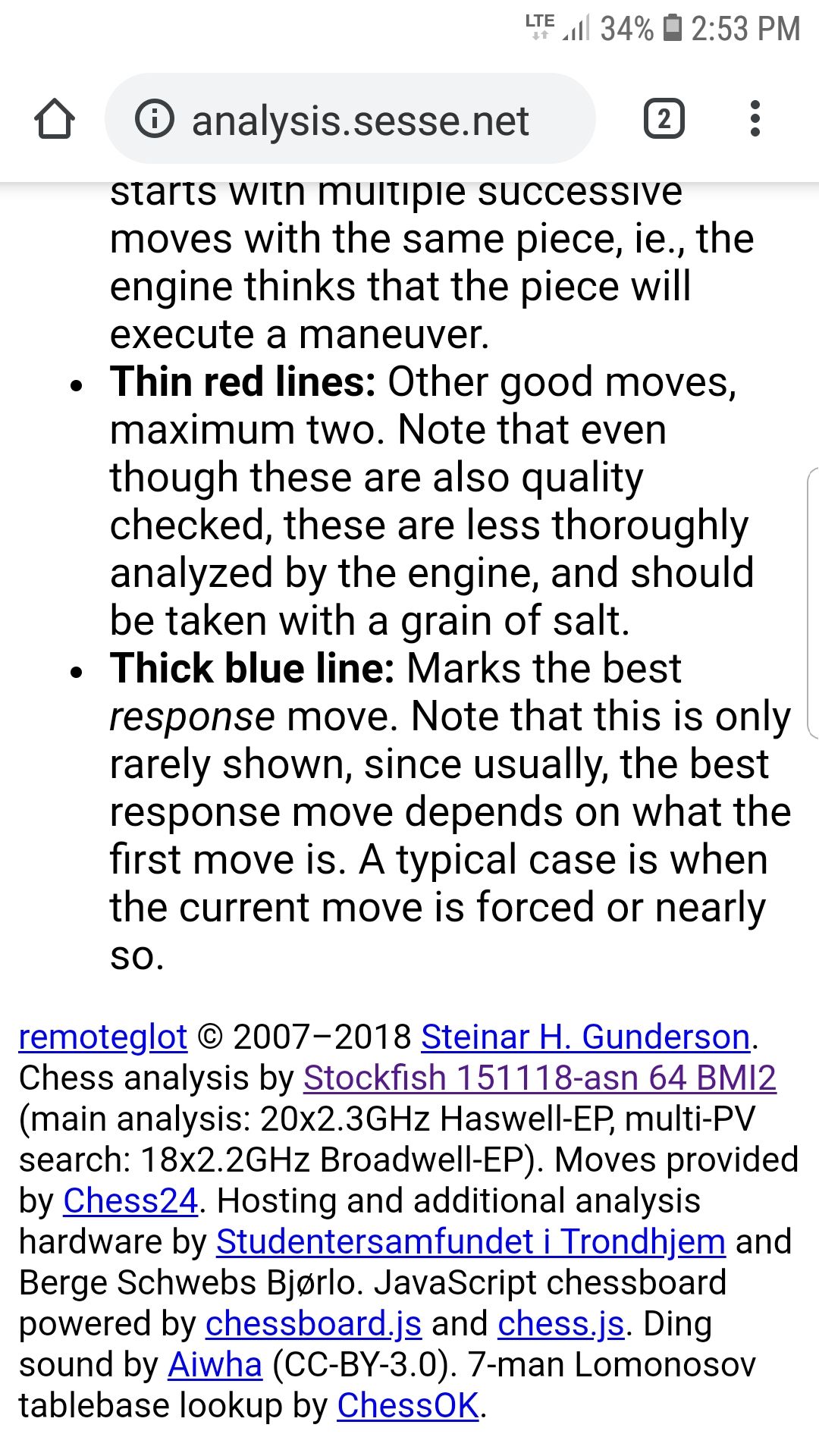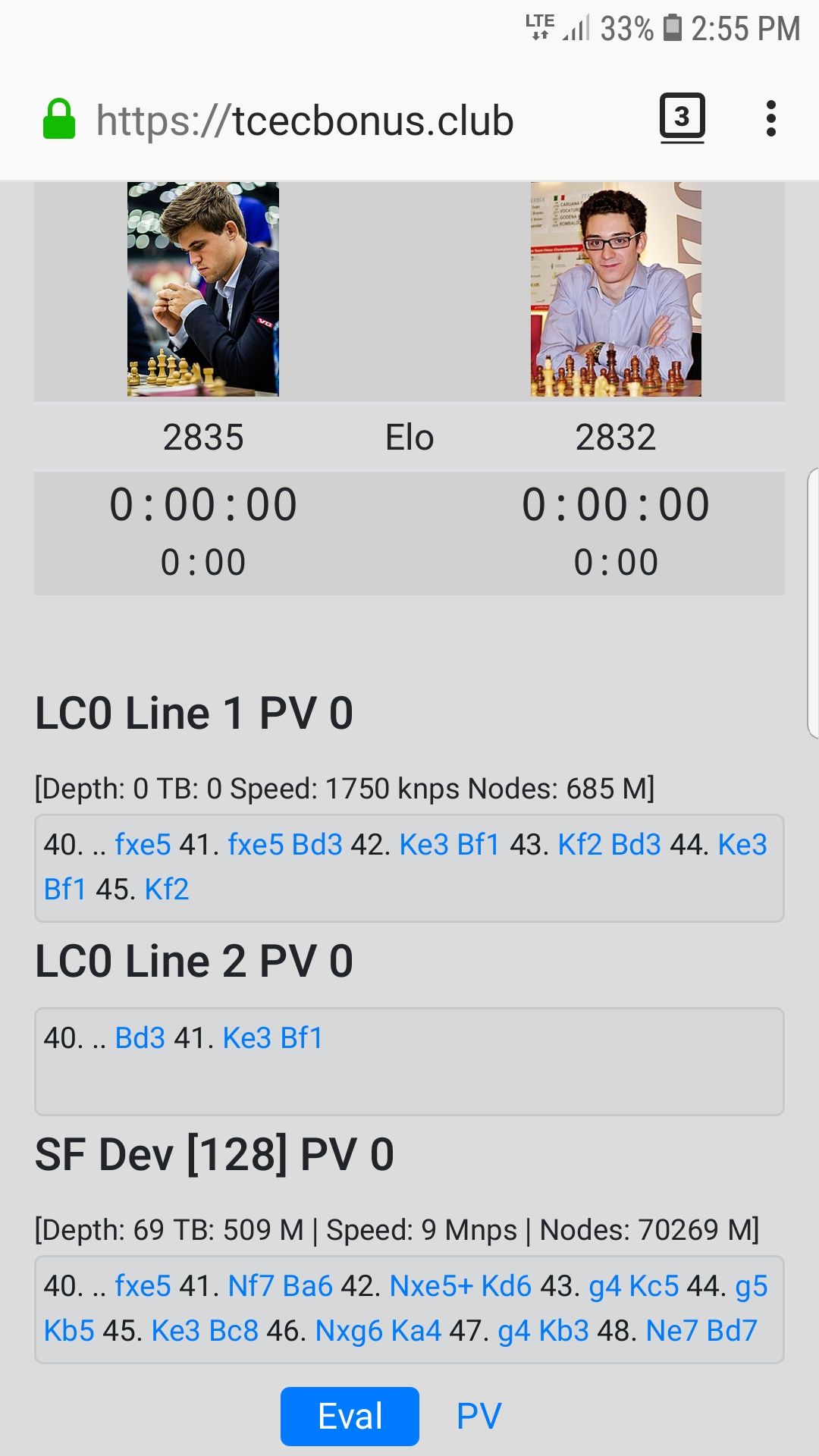https://www.chess.com/news/view/world-chess-championship-game-6-caruana-misses-nearly-impossible-win
Sesse isn't one of the top-rated chess engines.
Engines like stockfish, houdini, etc are software.
Sesse is hardware. A super computer. It can run stockfish (and other engines) but its hardware allows it to calculate much faster, and store much more (so see further).
It's no surprise that a website engine (stockfish running in your browser) can't find long sequences because even if you let it go to a high depth, it (presumably) wouldn't have enough memory to store what it's already looked at in hash, so after a certain point it's just going in circles (or ignoring a huge amount of moves).
Same reason people cried foul when AlphaZero beat Stockfish. They gave SF 60 cores but only 1 GB hash, which is silly.
So the forced mate was legit then?
What software was it running? Does anyone know who was inputting the moves? And I'm also wondering if anyone has yet fully understood this line and published it somewhere? Probably not, but I'd be curious to know when that comes out.
And I'm also wondering if anyone has yet fully understood this line and published it somewhere?
The bishop on g4 trapping the knight on g1 allowed the black king access to g8 and then h8. Once Black was able to blockade White's h-pawn, it was a question of running White out of moves until he is forced to move the bishop and allow the knight to escape via h3. Actually, it seems to be a series of zugzwang-based maneuvers, where Black uses his bishop to "lose" a move and force White to give something up. The little bishop dance is analogous to a triangulation maneuver by a king to gain the opposition in a king and pawn ending. In both cases, the purpose is to place the enemy in zugzwang.
With all of that in mind, go through the variation posted by stiggling and it will be easier to understand, I think.
So the forced mate was legit then?
What software was it running? Does anyone know who was inputting the moves? And I'm also wondering if anyone has yet fully understood this line and published it somewhere? Probably not, but I'd be curious to know when that comes out.
Yes, it's legit.
AFAIK Sesse was running stockfish.
It's a supercomputer in Norway, and since Carlsen is a celebrity in Norway, this engine always follows his games, and you can see the analysis online every time he plays through the year, or so I've heard.
So I imagine it's some government employee, or dedicated fan whose job gives them access to the supercomputer.
Anyway, you seem to think engines play perfectly, so if stockfish in your browser can't find a forced win, then it doesn't exist.
This is pretty silly. Engines lose against other engines all the time, and hardware and time control is very important. That's why something like CCRL (which I believe says stockfish is strongest) might not agree with TCEC (where Komodo beat stockfish).
Sure you can let an engine explore more and more positions, but again, letting it run for 24 hours (for example) is pointless if there isn't enough memory for it to store its results.
"That's why something like CCRL (which I believe says stockfish is strongest) might not agree with TCEC (where Komodo beat stockfish)."
Stockfish beat Komodo, https://en.wikipedia.org/wiki/TCEC#Tournament_results_(TCEC)
Anyway, you seem to think engines play perfectly, so if stockfish in your browser can't find a forced win, then it doesn't exist.
This is pretty silly.
No, I don't think engines play perfectly, not sure why my post came across as such. On the contrary, I was attempting to account for the exact opposite - a mistake by a chess engine. I was attempting clarify what to me sounded like rumours because I hadn't heard anything on the internet that I considered confirmation.
Ok, fair enough.
Although I can't help but read your post #11 as
"No, I don't think engines play perfectly . . . On the contrary, I was attempting to account for why they don't play perfectly"
(if you already think they're flawed then there's nothing to account for ![]() )
)
But ok, I know what you're saying, Stockfish is well known and Sesse is some unknown thing that's claiming to play better. I'd be asking the same thing.
15-ish years ago, when "Fritz" and "chess engine" were synonymous, there was a supercomputer called hydra that you'd sometimes hear about giving an evaluation... also I think Topolov had a match with Hydra? Can't quite remember and too lazy to google.
Sesse uses 20 cores stockfish plus 18 cores Multi PV ( that add additional 1 cores strength)= 21 cores stockfish.
TCEC bonus uses 128 cores stockfish, basically 6 times more powerful than sess.
See the screenshot.


Sesse is run by 20 cores stockfish plus 18 cores Multi PV ( that add additional 1 cores strength)= 21 cores stockfish.
Svidler said it did about 30,000 kn/s so I would have guessed about 20 cores, so that makes sense.
I guess TCEC is doing 100Mn/s? That's crazy.
Ok, I see in the picture 9Mn/s
But this is "only" 9000 kn/s right? Shouldn't a 128 core machine be doing 100Mn/s or is my math crazy?
Ok, I see in the picture 9Mn/s
But this is "only" 9000 kn/s right? Shouldn't a 128 core machine be doing 100Mn/s or is my math crazy?
Around 100 Mn/s in middle game(average). The nodes/ speed will be faster in more simple endgame position and slower in more complex early opening.
The game is not on live and the machine is not running. The GUI display of 9mn/s is incorrect.
Here's a blog that answers some of the OP's questions...
Carlsen-Caruana WCC Game 6 – The actual forced-mate sequence that was missed
A screenshot from behind the link provided by Rocky64 shows 62,5 Mn/s for sesse. In the final position of game 11 of the match you can see 5,5 Mn/s. Why does it differ so much? Maybe today I try to see what kind of max sesse has during game 12.
Great post and replies! I was wondering the same thing as I become serious about improving my chess. I figured that GMs aren't using browser engines and I wanted to know more about the subject.
The next thing I want to know is what are recommended specs for a personal pc/laptop that will be used for chess engine analysis? Are there viable alternatives to purchasing a strong pc/laptop for chess analysis?
I was interested to see the endgame unfold as it did in the recent World Chess Championship Game 6 between reigning world champion Magnus Carlsen and challenger Fabiano Caruana.
Apparently, as many watchers around the world were inputting the super-GM's moves into various chess engines to get a glimpse of the possible future, people cried out that White's 68th move, Bc4, was a blunder. One engine in particular, one I'd never heard of before called Sesse (sp?) found some kind of forced mate in 30 if Black responds with Bh4. It was, of course, a very non-human line, involving getting your own knight trapped by the opposing bishop at the bottom of the board. It came out in the press conference afterwards, and neither player, even looking at the chess engine's analysis on a computer screen, could fully comprehend it, nor could numerous other commentating GMs, nor other engines, apparently.
The most interesting thing to me, other than that this will be talked about in the chess world for centuries to come, is that not every engine can find this forced mate, and as far as I know. I plugged it into Chess.com's own Stockfish v9, set it to calculate unlimited, and after about 20 minutes, to a depth of 65, has only put Black at -4.14. Sesse isn't one of the top-rated chess engines. Which makes me wonder whether it might be some kind of processing mistake. For example, if we were to believe that the chess engines can't find every possible combination of moves, effectively solving the game of chess, and that evidence seems to point to the fact that top-rated chess engines can't seem to find this particular combination of moves, then it seems reasonable that Sesse could have missed some variations of the line which would render it NOT a forced mate after all. In other words, the combination of moves that it couldn't calculate was the refutation of 68. ... Bh4.
So my first question is, does anyone have access to this analysis? Or where can I find an online version of Sesse that I can plug this position into and see for myself (not that I would understand it)? And my second question is, without seeing any other GM's or computer's acceptance or refutation of the line, what do you think... could it be a mistake? Or is Sesse capable of seeing thing that other engines can't?